



- Details
-
Basic Information
EN 10217 P195 LSAW PIPE
Description: Longitudinal Submerged Arc Welded Pipe
Standard: EN 10217
Steel Grade: P195GH, P195TR1, P195TR2
Outside Diameter: 406mm - 1420mm
Wall Thickness: 10 - 50mm
Length: 5.8m ,6m ,12m, also depend on requirements
Pipe End: Flat end, Chamfer end, Groove, Thread
Coating: Black, Varnish , 3PE , Galvanized , Fused epoxy coating
Advantages: large diameter steel pipes, suitable for high-temperature environments, high-pressure resistance, low-temperature resistance, general structural applications.CLICK HERE➡The EN 10217 Standard
Chemical Composition
All three grades-P195GH, P195TR1, and P195TR2-share similar chemical compositions, which contribute to their specific properties and applications:Chemical Composition(cast analysis),max,% Steel Grade C Si Mn P S P195GH, P195TR1, P195TR2 0.13 0.35 0.70 0.025 0.020 ● Carbon (C): ≤0.13% for all grades. Low carbon content ensures good weldability and ductility, making these grades suitable for applications requiring extensive welding.
● Silicon (Si): 0.35% for all grades. Silicon acts as a deoxidizer and helps improve the steel's strength and hardness.
● Manganese (Mn): ≤0.70% for all grades. Manganese enhances strength and hardness while mitigating the adverse effects of sulfur.
● Phosphorus (P) and Sulfur (S): Both limited to 0.025% and 0.020%, respectively. These limits prevent embrittlement and ensure good ductility.
Mechanical PropertiesMechanical properties for wall thickness T≤16 Steel Grade Tensile properties at room temperature Yield strength, MPa Tensile strength, Mpa Elongation, % longitudinal transverse P195GH, P195TR1, P195TR2 195 320-440 27 25 ● Yield Strength: 195 MPa for all grades. This indicates the stress level at which the material begins to deform permanently, ensuring it can handle moderate loads without yielding.
● Tensile Strength: 320-440 MPa for all grades. This is the maximum stress the material can withstand before breaking, ensuring durability under high loads.
● Elongation: 27% in the longitudinal direction for P195GH and P195TR1, and 25% for P195TR2. High elongation means the material is ductile and can absorb more energy before failure, which is beneficial for applications requiring flexibility.
Differences Between Three Grades
● Impact Testing and Inspection Requirements: The primary difference lies in the impact testing and inspection standards. P195TR2 includes specified impact properties and more rigorous inspection criteria, making it suitable for applications where impact resistance is critical. P195TR1 does not have these specific requirements, and P195GH is designed for elevated temperature applications rather than impact resistance.
● Temperature and Pressure Resistance: P195GH is optimized for high-temperature environments, while P195TR2 is preferred for higher pressure and impact resistance applications.
● Versatility: P195TR1 is generally used for more general applications where moderate strength and good weldability are sufficient.
Applications And Advantages● P195GH
Applications: Designed for elevated temperature applications, such as pressure vessels and piping systems that operate at higher temperatures. It is suitable for environments where thermal stability is crucial.
Advantages: Offers good thermal stability and is suitable for high-temperature environments, making it ideal for power generation and industrial heating systems.
● P195TR1Applications: Used in general structural applications, such as building frames, parapets, and pipe supports. It is ideal for applications where impact resistance is not a primary concern.
Advantages: Provides a balance of strength and ductility without the need for additional impact testing, making it cost-effective for many general applications.
● P195TR2Applications: Suitable for applications requiring higher impact resistance and more stringent inspection standards, such as high-pressure boilers and critical structural components.
Advantages: Includes impact testing requirements and specific inspection criteria, ensuring higher reliability in high-stress and critical applications.
Overall, these grades are designed to meet the diverse needs of industries such as oil and gas, construction, and chemical processing, ensuring reliability and performance in various pressure applications.The EN 10217 Longitudinal Submerged Arc Welding (LSAW) Process
● Plate Inspection: The steel plates used for manufacturing are first subjected to ultrasonic testing to ensure there are no defects.
● Edge Milling: The edges of the steel plate are milled to achieve the required width, parallelism, and bevel shape. This ensures that the edges are properly prepared for welding.
● Pre-bending: The edges of the plate are pre-bent using a pre-bending machine to give them the necessary curvature. This step is crucial for forming the pipe correctly.
● Forming: The pre-bent plate is then formed into a tubular shape using a JCO forming machine. The process involves pressing the plate into a "J" shape, then a "C" shape, and finally an open "O" shape. This step is essential for creating the correct geometry of the pipe.
● Pre-welding: The formed pipe is pre-welded using gas shielded welding (MAG) to create a continuous seam. This initial weld helps hold the pipe together before the main welding process.
● Internal Welding: The inside of the pipe is welded using tandem multi-wire submerged arc welding (typically with four wires). This ensures a strong and uniform weld on the interior.
● External Welding: The outside of the pipe is also welded using tandem multi-wire submerged arc welding. This step is crucial for achieving a high-quality weld on the exterior of the pipe.
● Ultrasonic Testing: The internal and external welds, as well as the base material on both sides of the weld, are inspected using ultrasonic testing to detect any defects.
● X-ray Inspection: X-ray industrial TV inspection is conducted on the inside and outside of the pipe using an image processing system to ensure detection sensitivity and quality.
● Expansion: The pipe is expanded to improve its dimensional accuracy and to enhance the distribution of stress within the pipe. This step helps ensure that the pipe meets the required specifications.
● Hydraulic Testing: The expanded pipes are tested using a hydraulic pressure test to ensure they meet the required pressure standards. The testing machine typically has automatic recording and storage capabilities.
● Chamfering: The ends of the pipe are chamfered to achieve the required bevel size. This step is important for preparing the pipe for further processing or installation.The LSAW process is known for its efficiency and ability to produce pipes with high strength and durability, making it suitable for applications such as oil and gas pipelines.
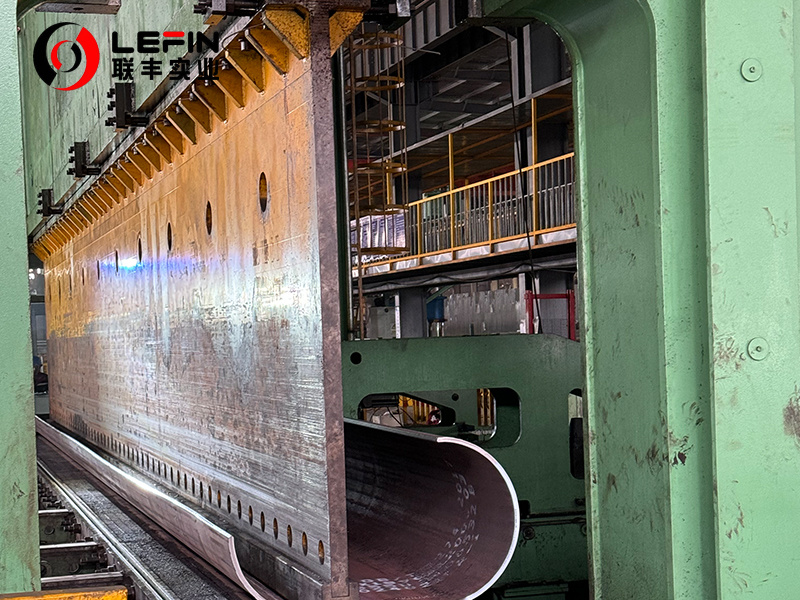
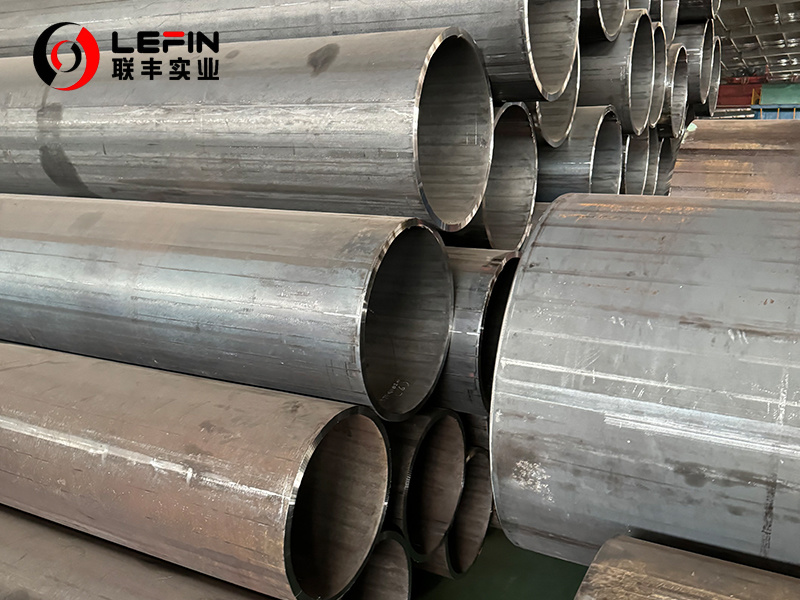
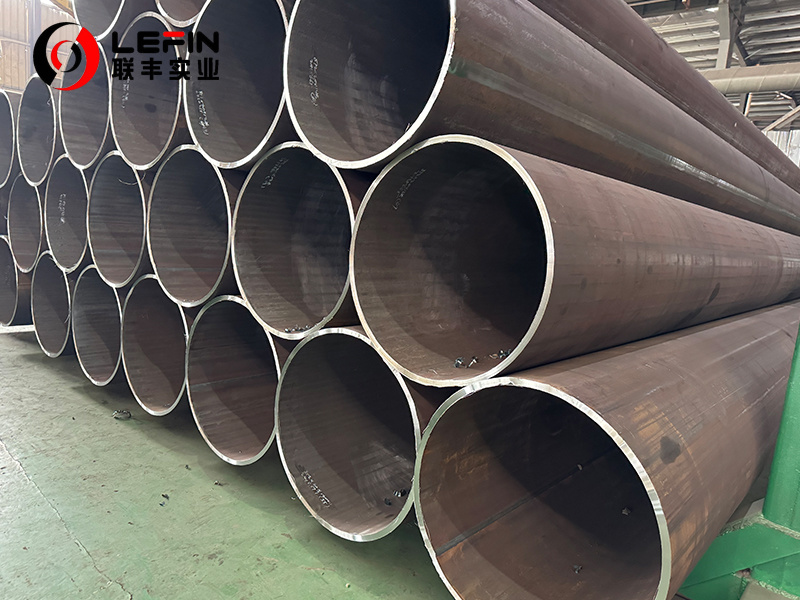
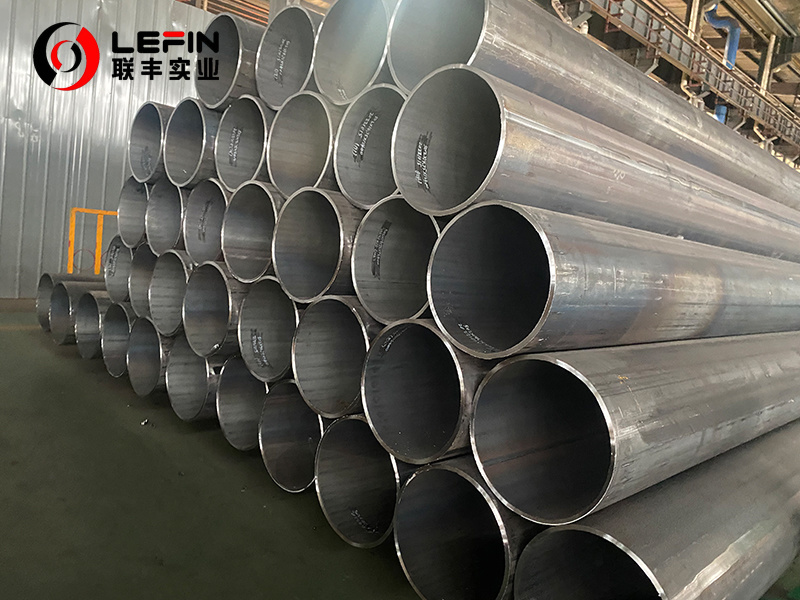
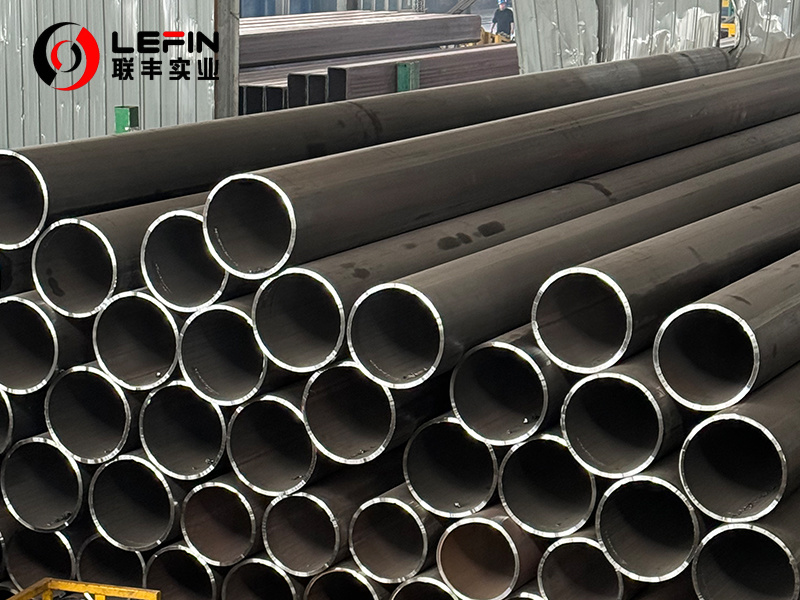
EN 10217 P195 LSAW PIPE
Subcategory
Keyword
- Details
-
Basic Information
EN 10217 P195 LSAW PIPE
Description: Longitudinal Submerged Arc Welded Pipe
Standard: EN 10217
Steel Grade: P195GH, P195TR1, P195TR2
Outside Diameter: 406mm - 1420mm
Wall Thickness: 10 - 50mm
Length: 5.8m ,6m ,12m, also depend on requirements
Pipe End: Flat end, Chamfer end, Groove, Thread
Coating: Black, Varnish , 3PE , Galvanized , Fused epoxy coating
Advantages: large diameter steel pipes, suitable for high-temperature environments, high-pressure resistance, low-temperature resistance, general structural applications.CLICK HERE➡The EN 10217 Standard
Chemical Composition
All three grades-P195GH, P195TR1, and P195TR2-share similar chemical compositions, which contribute to their specific properties and applications:Chemical Composition(cast analysis),max,% Steel Grade C Si Mn P S P195GH, P195TR1, P195TR2 0.13 0.35 0.70 0.025 0.020 ● Carbon (C): ≤0.13% for all grades. Low carbon content ensures good weldability and ductility, making these grades suitable for applications requiring extensive welding.
● Silicon (Si): 0.35% for all grades. Silicon acts as a deoxidizer and helps improve the steel's strength and hardness.
● Manganese (Mn): ≤0.70% for all grades. Manganese enhances strength and hardness while mitigating the adverse effects of sulfur.
● Phosphorus (P) and Sulfur (S): Both limited to 0.025% and 0.020%, respectively. These limits prevent embrittlement and ensure good ductility.
Mechanical PropertiesMechanical properties for wall thickness T≤16 Steel Grade Tensile properties at room temperature Yield strength, MPa Tensile strength, Mpa Elongation, % longitudinal transverse P195GH, P195TR1, P195TR2 195 320-440 27 25 ● Yield Strength: 195 MPa for all grades. This indicates the stress level at which the material begins to deform permanently, ensuring it can handle moderate loads without yielding.
● Tensile Strength: 320-440 MPa for all grades. This is the maximum stress the material can withstand before breaking, ensuring durability under high loads.
● Elongation: 27% in the longitudinal direction for P195GH and P195TR1, and 25% for P195TR2. High elongation means the material is ductile and can absorb more energy before failure, which is beneficial for applications requiring flexibility.
Differences Between Three Grades
● Impact Testing and Inspection Requirements: The primary difference lies in the impact testing and inspection standards. P195TR2 includes specified impact properties and more rigorous inspection criteria, making it suitable for applications where impact resistance is critical. P195TR1 does not have these specific requirements, and P195GH is designed for elevated temperature applications rather than impact resistance.
● Temperature and Pressure Resistance: P195GH is optimized for high-temperature environments, while P195TR2 is preferred for higher pressure and impact resistance applications.
● Versatility: P195TR1 is generally used for more general applications where moderate strength and good weldability are sufficient.
Applications And Advantages● P195GH
Applications: Designed for elevated temperature applications, such as pressure vessels and piping systems that operate at higher temperatures. It is suitable for environments where thermal stability is crucial.
Advantages: Offers good thermal stability and is suitable for high-temperature environments, making it ideal for power generation and industrial heating systems.
● P195TR1Applications: Used in general structural applications, such as building frames, parapets, and pipe supports. It is ideal for applications where impact resistance is not a primary concern.
Advantages: Provides a balance of strength and ductility without the need for additional impact testing, making it cost-effective for many general applications.
● P195TR2Applications: Suitable for applications requiring higher impact resistance and more stringent inspection standards, such as high-pressure boilers and critical structural components.
Advantages: Includes impact testing requirements and specific inspection criteria, ensuring higher reliability in high-stress and critical applications.
Overall, these grades are designed to meet the diverse needs of industries such as oil and gas, construction, and chemical processing, ensuring reliability and performance in various pressure applications.The EN 10217 Longitudinal Submerged Arc Welding (LSAW) Process
● Plate Inspection: The steel plates used for manufacturing are first subjected to ultrasonic testing to ensure there are no defects.
● Edge Milling: The edges of the steel plate are milled to achieve the required width, parallelism, and bevel shape. This ensures that the edges are properly prepared for welding.
● Pre-bending: The edges of the plate are pre-bent using a pre-bending machine to give them the necessary curvature. This step is crucial for forming the pipe correctly.
● Forming: The pre-bent plate is then formed into a tubular shape using a JCO forming machine. The process involves pressing the plate into a "J" shape, then a "C" shape, and finally an open "O" shape. This step is essential for creating the correct geometry of the pipe.
● Pre-welding: The formed pipe is pre-welded using gas shielded welding (MAG) to create a continuous seam. This initial weld helps hold the pipe together before the main welding process.
● Internal Welding: The inside of the pipe is welded using tandem multi-wire submerged arc welding (typically with four wires). This ensures a strong and uniform weld on the interior.
● External Welding: The outside of the pipe is also welded using tandem multi-wire submerged arc welding. This step is crucial for achieving a high-quality weld on the exterior of the pipe.
● Ultrasonic Testing: The internal and external welds, as well as the base material on both sides of the weld, are inspected using ultrasonic testing to detect any defects.
● X-ray Inspection: X-ray industrial TV inspection is conducted on the inside and outside of the pipe using an image processing system to ensure detection sensitivity and quality.
● Expansion: The pipe is expanded to improve its dimensional accuracy and to enhance the distribution of stress within the pipe. This step helps ensure that the pipe meets the required specifications.
● Hydraulic Testing: The expanded pipes are tested using a hydraulic pressure test to ensure they meet the required pressure standards. The testing machine typically has automatic recording and storage capabilities.
● Chamfering: The ends of the pipe are chamfered to achieve the required bevel size. This step is important for preparing the pipe for further processing or installation.The LSAW process is known for its efficiency and ability to produce pipes with high strength and durability, making it suitable for applications such as oil and gas pipelines.





Related products
Product Consulting

Address: Hengtai Road,Daqiuzhuang Town,Jinghai County,Tianjin,China
Mob: +8615122229899(whatspp)
Phone: +86 22 58171905
Fax: +86 22 58171902
E-mail:info@lefinsteel.com
Get company updates

Tianjin Lefin Industrial Co.,Ltd. All rights reserved City sub-station SEO www.300.cn

